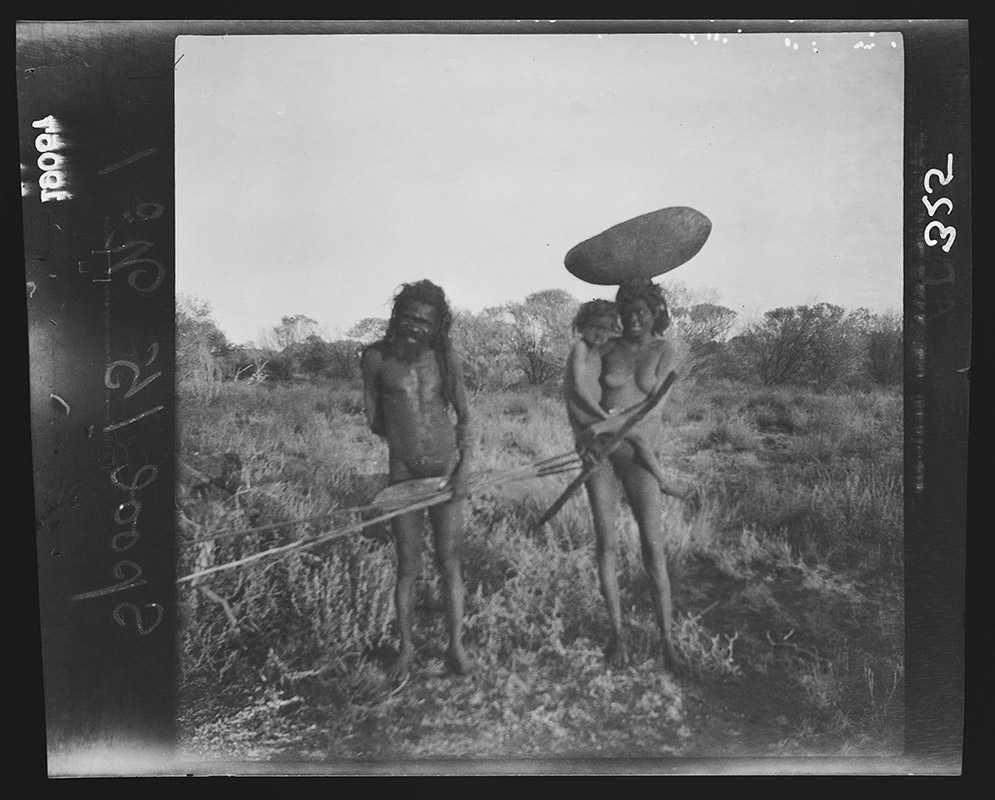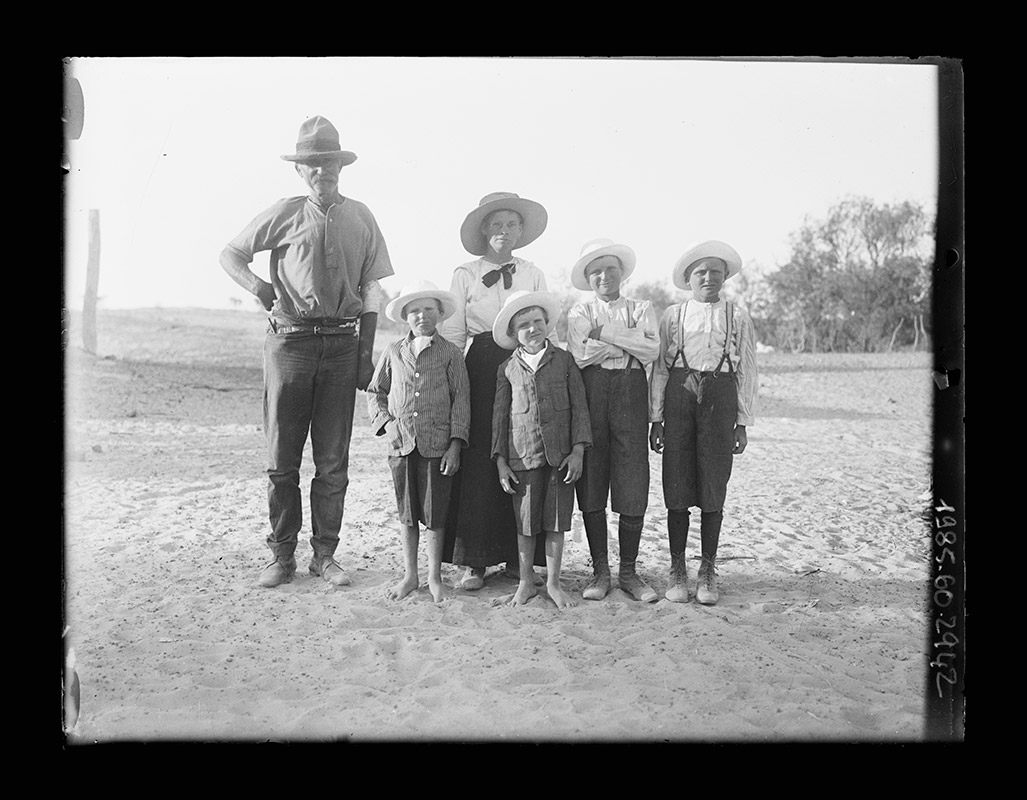Learning activities
Outcomes
In the activities described below, students understand photography as a way of documenting family history, and consider the differences between photography today and in the past, recognise that 3D imaging began a long time ago and can be done in different ways and experiment with seeing and creating stereoscopic images.
Materials
- 4-minute video about stereoscopes
- image of a 19th-century German picture puzzle (print to share)
- instructions for making stereoscopic images on the New York Public Library's Stereogranimator web page make your own stereoscopic image
- instructions for making 3D glasses: using markers to colour a clear surface or using coloured acetate
- historical images provided in the slideshow or in the A3 printouts below.
Preparation
With your students, watch the video 'What is this? Stereoscope'.
Does anyone in the class have a View-Master? (This is the modern-day equivalent of a stereoscope. If so, ask them to bring it to class.)
Ask each student to bring in a photograph of themselves and their family.
The opening of the video shows rainbow stripes moving across the screen from left to right. A cloud shape pops into the coloured stripes containing an image of a wooden stereoscope. The video title 'What is this' is superimposed on the stereoscope. A question mark bounces into position at the end of the text ('What is this?') and an eyeball rolls around in the dot forming the bottom of the question mark and winks. Upbeat music plays in the background. A swarm of question marks moves across and fills the frame.
Angela the presenter stands behind a desk. She is holding and looking into a wooden object.
Teddy the puppet is on the right. Above Teddy in the top right part of a screen is an animated television graphic. Spinning question marks appear in the TV screen.
TEDDY: What is this? You must be able to look through it, just like Angela is doing, because it's got two eyepieces.
(Angela takes object away from her face.)
ANGELA: Could it be a mask?
(Angela looks through the object.)
TEDDY: That's a good idea! A mask goes over your face and you can see through the two holes. I think it might be made of wood, too.
(Angela takes the object from her face and rubs her hand over the object. Close-up of her hand passing over the top of the object.)
ANGELA: Well it definitely feels like it's made from wood.
(Angela holds the object out for Teddy to feel. Teddy runs his paws across it.)
TEDDY: Oh yeah.
ANGELA: And it has a handle underneath for holding it up to your face. And also this long piece of wood sticking out the front just below the eyepieces.
(Angela points to the components of the object as she describes them. She points to the object's handle which is 'T'-shaped. At the end of the handle is an oval viewer with two square eye holes.)
TEDDY: If it was a mask, that would make you look like you have a very long, thin nose — like Pinocchio (laughs).
(Angela puts the object back to her face, pretending it's a mask.)
ANGELA: This might help you figure out what it is, Teddy.
(Wide shot of Angela and Teddy with the object on the desk between them. Angela produces a card with a photo mounted on it that she shows to Teddy.)
ANGELA: What can you see?
TEDDY: It's a photograph about the size of a postcard. The people in the photo are wearing old-fashioned clothes, and it's black and white.
(Close-up of the photograph is shown and, as Teddy describes it, it appears in the animated television screen above him.)
ANGELA: That's right. And there is something else you might find a bit strange about the photo.
(A pan across the photo, shows two apparently identical images of people dressed in formal clothes early 20th-century clothing, including top hats. Below photo text reads 'The American Fleet in Australia'.)
TEDDY: It has two of the same picture, side by side.
TEDDY: What's that at the end of the long piece of wood at the front? It looks like it has a bracket on it.
(Angela points to the metal bracket.)
ANGELA: Well, Teddy. It looks like you've discovered another piece of the puzzle. Let me give you another clue.
(Angela takes the photo and slots it into bracket.)
TEDDY: Ah! I see. That bracket at the front is for holding the photograph and it sits right in front of the two eyepieces! Is it for looking at photos, Angela?
(Angela turns the object to face camera. The photo can be seen through the square eye holes.)
ANGELA: It is. This is called a stereoscope.
(The word 'stereoscope' appears in the animated television screen.)
ANGELA: Stereoscopes were very popular around 150 years ago.
(Close-up of the stereoscope. Angela rotates it so all the parts can be clearly seen.)
TEDDY: 150 years! That's even older than you.
ANGELA: (laughs) It certainly is, Teddy. A stereoscope lets us see these special photographs in 3D.
(Angela touches the photo in the bracket.)
ANGELA: Here. Have a go.
(Angela holds the stereoscope eyepieces up to Teddy's face.)
TEDDY: Oh!
ANGELA: At first, you see two separate images. As you slide the photo along the wooden arm at the front of the stereoscope …
(Angela slides the photo in its bracket. The camera switches to Teddy's point of view. The two images move together and become one, with the people in the photo standing out in the foreground in a simulated 3D effect.)
TEDDY: Ooh, the images move together and become 3D.
(Angela removes the stereograph from Teddy's face.)
TEDDY: That's very clever.
TEDDY: Why don't we use these anymore, Angela?
ANGELA: These days we have different ways of creating 3D images.
TEDDY: Oh, yes. I saw a 3D movie with dancing penguins on my birthday.
ANGELA: In the past, when the stereoscope was popular, people lived in a world that didn't yet have television or movies or the internet.
TEDDY: So, the stereoscope was one way of having fun ...
ANGELA: ... by looking at lifelike pictures of interesting and beautiful places.
(The animated television screen shows more stereograph images, first of people gathered near a rock outcropping facing camera, then of a streetscape with buildings.)
ANGELA: When people went on holidays, they could buy stereoscopic pictures of the places they visited.
TEDDY: They could show the pictures to their friends when they got home — like when I made a video of my holiday at the beach.
ANGELA: Yes. That was a lot of fun. It made me very jealous, Teddy.
TEDDY: Ha ha! That was my aim. Except it wasn't in 3D.
ANGELA: Objects from the past can tell us lots of things about what life was like back then. They're full of clues and stories.
TEDDY: And asking questions is a fantastic way to explore the stories of those objects.
ANGELA: Come on, Teddy. Let's have another look at that photograph.
(Angela holds the stereoscope up to Teddy's face.)
ANGELA: What else can you see?
TEDDY: There are flags on a rope way above all the people.
(Simulated 3D image of photo is shown.)
TEDDY: Must be some kind of celebration ...
ANGELA: See you later.
TEDDY: Bye.
(Upbeat music plays. Teddy turns back to the stereoscope. Another point of view shot from the eyepiece.)
TEDDY: Hey, Angela. It's kind of weird that nobody's looking at the camera.
ANGELA: Maybe they're watching something.
TEDDY: Or just very shy ...
Upbeat music. An animation of rainbow stripes moving across the screen from left to right. A cloud shape pops into the coloured stripes containing an image of a stereoscope. The video title 'What is this?' is superimposed on the stereoscope. This dissolves to National Museum of Australia logo.
A3 printouts
- Download Stereoscopic photograph of stereoscope being used478.5 kb pdf [ PDF | 478.5 kb ]
- Download Dinjimanne and family 1903497.7 kb pdf [ PDF | 497.7 kb ]
- Download McAuley family 1919465.1 kb pdf [ PDF | 465.1 kb ]
1. Discussion
Activities
Hold a class conversation about photography, covering the following questions and issues:
- Do you sometimes look at photographs of yourself when you were younger? When do you take photographs and what for? Explore the circumstances in which the students appear in photographs, or in which they take photographs — birthdays, holidays etc. Discuss how photographs enable people to see something without being there, or to remember something from the past.
- Have you ever seen photographs of your parents or grandparents or great-grandparents when they were young? Did the pictures surprise you at all? If so, what was surprising? As well as noticing that the people in their family looked different when they were young, the children might have noticed changes in clothing style, vehicles, or the setting for the photograph.
- How do you think cameras and photographs today are different from cameras in the past? Today, almost anyone can 'do' photography; it is cheaper, easier and quicker to make an image. Many children now take photographs.
- How does the stereoscope give you a better view of a scene than an ordinary photograph? (3D provides a more lifelike experience of a scene than a flat 2D image.)
2. Exploring stereography
Activities
If you have access to a View-Master and reel of photos, invite students to take turns in seeing the images through it.
Also show the class the stereoscopic image of the woman using a stereoscope.
Invite students to ask questions about either or both:
- the View-Master and its reel of images
- the stereoscope and the stereoscopic image
Write a list of their questions, then discuss how they might go about finding out the answers.
3. Family photographs
Activities
Most photographs are not stereographic. Ask students to speculate on when they might want to make a stereographic photograph, and when they might prefer to take an ordinary photograph.
Have each student look carefully at their family photograph alongside one of the historical photographs of a family in the slideshow — Dinjimanne and family or the McAuley family — and compare the two.
- Ask students to consider, in each case, who took the photograph, where, when and why.
- Write a caption for each photograph, describing the scene.
- Create two lists: things that are the same, and things that are different.
4. 3D imagery as an optical illusion
Activities
Show students a printout of the 19th-century German picture puzzle. Can they see how it shows two different scenes in one? Like a stereographic image, this image is actually two separate drawings in one.
The New York Public Library has made a website for easily creating 3D images from the stereographs in its collection. You can start by seeing a pre-made image of people in an early motor vehicle.
Next follow the link to 'Create a new image', either using the same stereograph or a new one. Drag the images further apart or closer together until they are best positioned to create the illusion of three dimensions. You can set the speed of the animation to 'medium' or 'slow' if the flickering is too unsettling.
As an alternative to creating an animated GIF image (which flickers back and forth between the two images), you can create a 3D ‘anaglyph’. To view this in 3D, you’ll need to create some 3D glasses.
Explore more on What is this?
Explore more on What is this?

